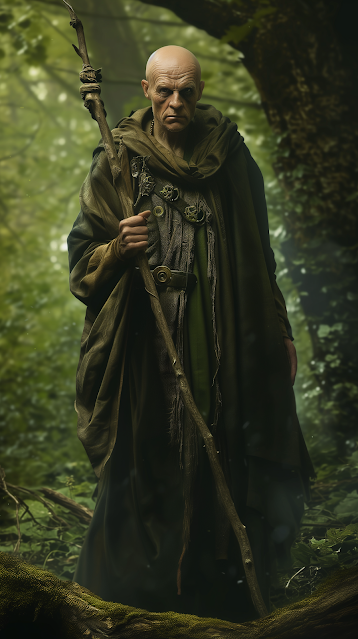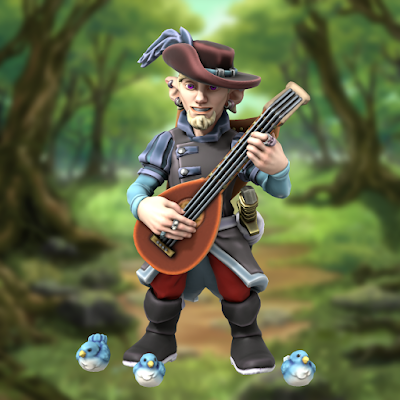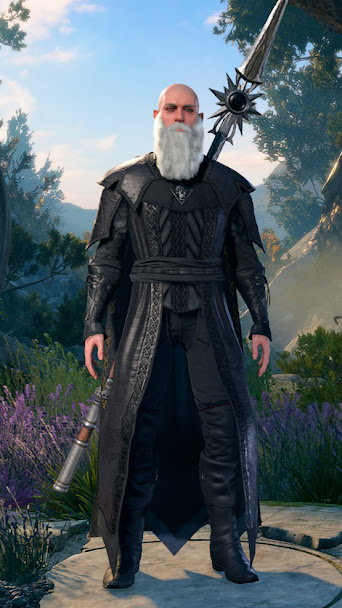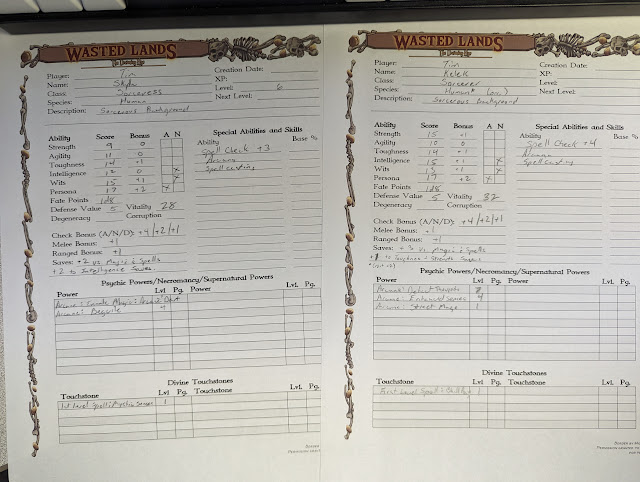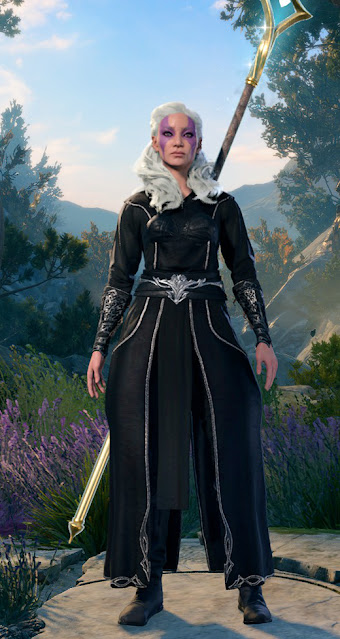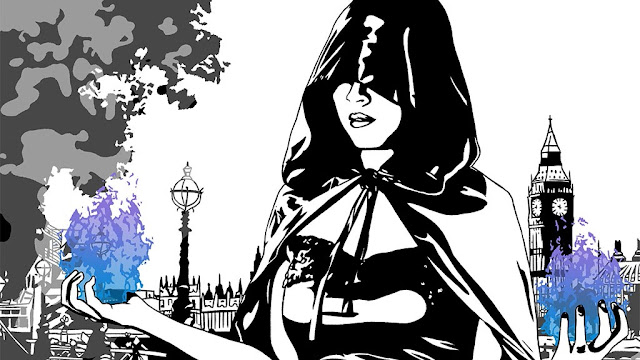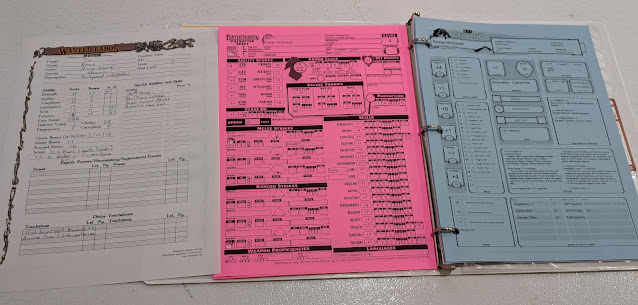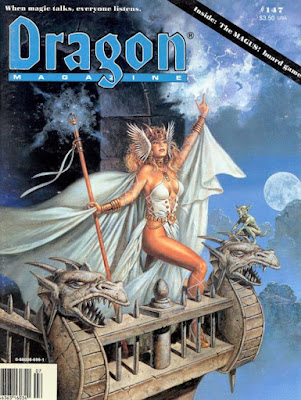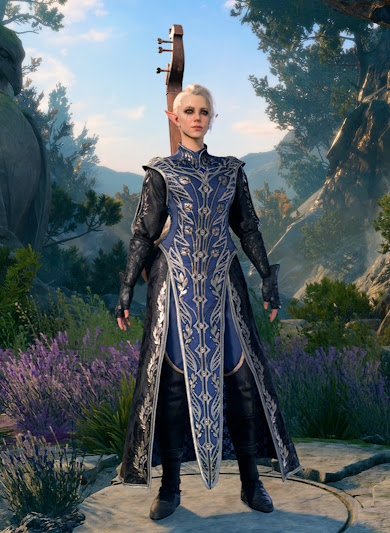Friday Fantasy: The Haunted Hamlet & other hexes
 The Haunted Hamlet & other hexes is an anthology of four locations and scenarios, of which one is the eponymous ‘Haunted Hamlet’. Each location combines a fantastic mixture of whimsy and weirdness, menace and mystery, and distinct usefulness. The latter because each of the four locations is not just a single location, but also a single hex, complete and separate from the other three. The Game Master can take any one of the four hexes and not so much drop it into her campaign, but neatly and tidily pull out a hex from her own hexcrawl and slot one of the four back in its place. After that, all the Game Master has to do, is add a few rumours to arouse the interest of her players and their characters to get them to visit and investigate. For example, the hexes can be used in conjunction with other books by the publisher such as Woodfall, Willow, and The Toxic Wood, or any one of the four hexes or adventure locations in The Haunted Hamlet & other hexes would make for easy additions to Populated Hexes Monthly Year One or the Dolmenwood setting from Necrotic Gnome. Then again, any one of the four could be run on their as a separate scenario, each one offering sufficient play for two or three sessions or so. All are written for use with Old School Essentials, Necrotic Gnome’s very accessible update of the Moldvey/Cook and Marsh version of Basic Dungeons & Dragons, which means that not only is The Haunted Hamlet & other hexes equally as mechanically accessible, it is also easily adapted to the retroclone of the Game Master’s choice.
The Haunted Hamlet & other hexes is an anthology of four locations and scenarios, of which one is the eponymous ‘Haunted Hamlet’. Each location combines a fantastic mixture of whimsy and weirdness, menace and mystery, and distinct usefulness. The latter because each of the four locations is not just a single location, but also a single hex, complete and separate from the other three. The Game Master can take any one of the four hexes and not so much drop it into her campaign, but neatly and tidily pull out a hex from her own hexcrawl and slot one of the four back in its place. After that, all the Game Master has to do, is add a few rumours to arouse the interest of her players and their characters to get them to visit and investigate. For example, the hexes can be used in conjunction with other books by the publisher such as Woodfall, Willow, and The Toxic Wood, or any one of the four hexes or adventure locations in The Haunted Hamlet & other hexes would make for easy additions to Populated Hexes Monthly Year One or the Dolmenwood setting from Necrotic Gnome. Then again, any one of the four could be run on their as a separate scenario, each one offering sufficient play for two or three sessions or so. All are written for use with Old School Essentials, Necrotic Gnome’s very accessible update of the Moldvey/Cook and Marsh version of Basic Dungeons & Dragons, which means that not only is The Haunted Hamlet & other hexes equally as mechanically accessible, it is also easily adapted to the retroclone of the Game Master’s choice.The Haunted Hamlet & other hexes is written by the Lazy Litch and was published following a successful Kickstarter campaign as part of ZineQuest #3. It begins in a slightly odd fashion with several sets of tables, one for ‘Random Treasure’—Basic, Advanced, and Rare—which can be rolled on as the Player Characters discover treasures during play; another for ‘Random Weather Conditions’—Basic Weather, Extreme Weather, and Natural Disasters; and then encounter seeds for both day and night, before the introduction. This sets the play style for all four hexes, that ideally play should be Player Character led according to their goals, that Player Characters gain Experience Points from finding treasures and making discoveries rather than simply killing monsters, that monsters are not balanced according to Player Character Level, and that in encouraging players to be clever and creative, that both roleplaying and meta-gaming is also encouraged. The latter is something of an oddity, a type of behaviour rarely encouraged in roleplaying in general since it can lead to players taking advantage of the situation. However, judicious application can lead to clever and interesting play. Then, The Haunted Hamlet & other hexes into its first hex, but it is not that of ‘The Haunted Hamlet’ of the title, adding to the oddness of the fanzine’s beginning. In addition, there is no table of contents which would tell the reader where it is, so it is disconcerting, at least initially.
‘The Gold Mine’ is the first hex in The Haunted Hamlet & other hexes. This details a great crack in the earth which has recently opened. It has been occupied by the forces of Lord Bleak of the Black Mountain, who are guarding it and forcing miners to extract the gold discovered below. The militia occupy a fort above where the ore is processed by alchemists, descending only to collect the ore and punish any delays in output. Below the fortress lies four quite different mining levels, each occupied by a different species. The upper mines by Mole people, the lower mines by subterranean Gnomes, the Antkin mines by the Antkin—the original dwellers of the mines and caves, and below that, the Overdark lies unoccupied except for strange pillars and fungal trees. The maps are presented in isometric fashion, the individual level descriptions coded in increasing darker shades of grey. At the end is a short timeline of events and a handful of hooks to get the Player Characters involved. These include them being incarcerated in the mine, being hired to break a criminal out or sabotage the mine, and so on. Even if the Player Characters do nothing, events will play out and the situation at the mine will be entirely different. There is a sense of oppression and things waiting to happen here.
Darker still though, is the second hex, ‘The Ladder Inn’. It describes a lakeside inn noted for the ladder descending into the waters of the lake. Treasure is rumoured to be found at the bottom of the ladder and the lake, and many an adventurer has passed through, expressing an interest in the mystery of lake and ladder, perhaps taking up the offer of potions of water breathing being sold by a stranger. Some pass on the offer, but others are never seen again. The inn, its owner and the stranger are all nicely detailed and there is lots going on at the inn over the course of the few days that the Player Characters stay there. The situation at the inn has a fairy tale-like quality to it, being a story of greed and oppression wrapped up in a mystery. A nice touch is that again, the areas underground—in this case, under the lake—on presented on a black background so that the Game Master is accorded the oppressive nature of the lake’s black waters… ‘The Ladder Inn’ is an enjoyably busy little location that intrigues with its odd situation—that of a ladder leading down into a lake—and then builds on that intrigue to deliver a dark little mystery with just a tinge of sadness.
Combine an overly ambitious wizard’s apprentice gone rogue, a strange fusion device, and a bale of hats, and what you have is ‘The Hat Cult’s Hideout’. The fusion device is used to combine one animal with another or a being with an animal, and all of the hats are magical. The wizard’s apprentice has formed a cult around him and its members not each get a magical hat, but have been gleefully experimenting with the fusion device, resulting in a rash of missing villagers and animals and then strange creatures lurking in the woods around the cave where the cult has its base. The cult itself is not evil, necessarily, just proud, misguided, and unaware of the dangers its research and its experiments might—and actually will—unleash on the surrounding area if left unchecked. It needs a few magical hats and the Game Master will need generate some magical creatures from the table given, such as an unstable giant snail with the head of a horse and 50% chance of exploding. As with the other hexes, there is a table of rumours, a list of reactions to the actions of the Player Characters, and timeline of events, which will drive the encounter. ‘The Hat Cult’s Hideout’ is also quite a tough little encounter, but this is not an encounter that need be solved with violence much in keeping with the introduction to The Haunted Hamlet & other hexes.
The last of the four entries in The Haunted Hamlet & other hexes is the eponymous ‘The Haunted Hamlet’. Where the motivations have been greed, loneliness, and pride for the situations in the other three hexes, here it is a combination of fear and evil. If the Player Characters descend into the valley of Wolvendale and its lonely town, they find themselves trapped and assailed by angry ghosts. The former leaders of the town committed a heinous act which condemned their lives and those of the villagers and the latter want their revenge. In order to escape the situation, the Player Characters must explore each of the few remaining buildings in the town, each one occupied by the ghosts of its former leaders and attempt to solve a puzzle that will force those ghosts to confront their action and its consequences. The problem is that the Player Characters are not necessarily going to know that they need to solve a problem. It is weird and creepy and there is an impending sense of doom and urgency as ghosts lurk and wounds fester, but lacks the hook to put the Player Characters onto the first step of the mystery. With an adjustment and perhaps a clue or two and the ‘The Haunted Hamlet’ will be a decent encounter.
Finally, the back cover of The Haunted Hamlet & other hexes details another location, the village of ‘Orgul’. This inverts the roles that evil monsters typically play in Dungeons & Dragons-style roleplaying game with the village being a refuge for reformed monsters who have pacifists after being forced to serve a dark lord. There is a table of random events to beset the village, but otherwise, this is hex ready to play with the players’ expectations and add characterisation to what are normally regarded as monsters to kill.
Between all of this, The Haunted Hamlet & other hexes includes a set of digest-sized cards. In turn, they depict and detail a band of adventurers in the service of the Spore Lord, stealing the treasures of other adventurers and attempting to raid dungeons before other adventurers get there; Heart String Knights are undead knights who died on their given quests, but are duty bound to complete before they can move and take great affront when others complete their quests; table of random NPCs and potions; a pair of hirelings; and the Sky Merchant, a floating vendor and emporium which can descend from the sky to sell goods and items at almost any time in the wilderness or on the road. There is a good mix of the whimsy and the usefulness to all of this, though it is actually independent of The Haunted Hamlet & other hexes just as the hexes in the fanzine are independent of each other and any particular setting.
Physically, The Haunted Hamlet & other hexes is mostly done in black and white, but there are touches of grey here and there, judiciously used to highlight certain sections. It is well written and organised, and the maps and artwork are all excellent. There are a couple of layout issues which have caused crashes with the text, so the PDF version may need to be referred to.
As in Woodfall, the author of The Haunted Hamlet & other hexes has already proven himself capable of combining the whimsical and the weird to great storytelling effect. With The Haunted Hamlet & other hexes, the author succeeds with the majority of the fanzine’s content. The first three of its hexes are easy to use and can just be slotted into the Game Master’s campaign with only minor adjustment. The fourth hex, though, requires development to work effectively. The three other hexes are excellent adventure locations, ‘The Ladder Inn’ and ‘The Hat Cult’s Hideout’ in particular. Overall, The Haunted Hamlet & other hexes is a good, but not quite great resource of ready-to-play content for any Game Master.



